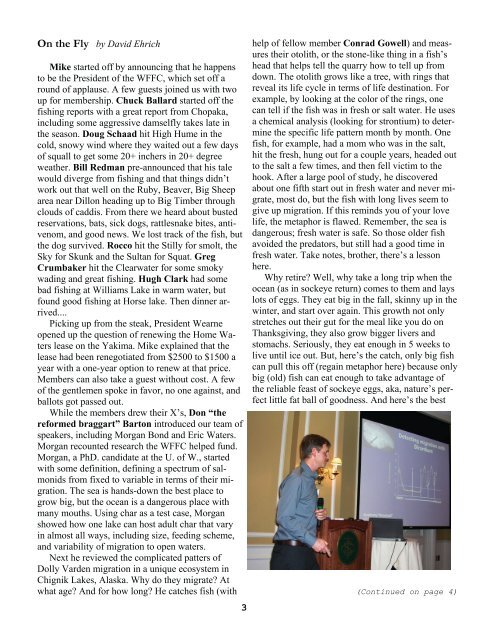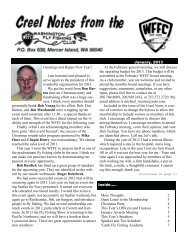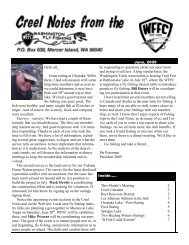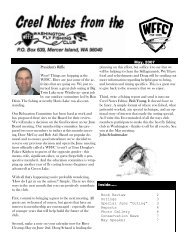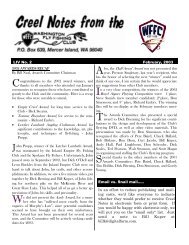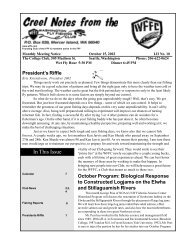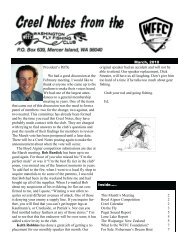Creel Notes - Washington Fly Fishing Club
Creel Notes - Washington Fly Fishing Club
Creel Notes - Washington Fly Fishing Club
You also want an ePaper? Increase the reach of your titles
YUMPU automatically turns print PDFs into web optimized ePapers that Google loves.
On the <strong>Fly</strong> by David Ehrich<br />
Mike started off by announcing that he happens<br />
to be the President of the WFFC, which set off a<br />
round of applause. A few guests joined us with two<br />
up for membership. Chuck Ballard started off the<br />
fishing reports with a great report from Chopaka,<br />
including some aggressive damselfly takes late in<br />
the season. Doug Schaad hit High Hume in the<br />
cold, snowy wind where they waited out a few days<br />
of squall to get some 20+ inchers in 20+ degree<br />
weather. Bill Redman pre-announced that his tale<br />
would diverge from fishing and that things didn’t<br />
work out that well on the Ruby, Beaver, Big Sheep<br />
area near Dillon heading up to Big Timber through<br />
clouds of caddis. From there we heard about busted<br />
reservations, bats, sick dogs, rattlesnake bites, antivenom,<br />
and good news. We lost track of the fish, but<br />
the dog survived. Rocco hit the Stilly for smolt, the<br />
Sky for Skunk and the Sultan for Squat. Greg<br />
Crumbaker hit the Clearwater for some smoky<br />
wading and great fishing. Hugh Clark had some<br />
bad fishing at Williams Lake in warm water, but<br />
found good fishing at Horse lake. Then dinner arrived....<br />
Picking up from the steak, President Wearne<br />
opened up the question of renewing the Home Waters<br />
lease on the Yakima. Mike explained that the<br />
lease had been renegotiated from $2500 to $1500 a<br />
year with a one-year option to renew at that price.<br />
Members can also take a guest without cost. A few<br />
of the gentlemen spoke in favor, no one against, and<br />
ballots got passed out.<br />
While the members drew their X’s, Don “the<br />
reformed braggart” Barton introduced our team of<br />
speakers, including Morgan Bond and Eric Waters.<br />
Morgan recounted research the WFFC helped fund.<br />
Morgan, a PhD. candidate at the U. of W., started<br />
with some definition, defining a spectrum of salmonids<br />
from fixed to variable in terms of their migration.<br />
The sea is hands-down the best place to<br />
grow big, but the ocean is a dangerous place with<br />
many mouths. Using char as a test case, Morgan<br />
showed how one lake can host adult char that vary<br />
in almost all ways, including size, feeding scheme,<br />
and variability of migration to open waters.<br />
Next he reviewed the complicated patters of<br />
Dolly Varden migration in a unique ecosystem in<br />
Chignik Lakes, Alaska. Why do they migrate? At<br />
what age? And for how long? He catches fish (with<br />
3<br />
help of fellow member Conrad Gowell) and measures<br />
their otolith, or the stone-like thing in a fish’s<br />
head that helps tell the quarry how to tell up from<br />
down. The otolith grows like a tree, with rings that<br />
reveal its life cycle in terms of life destination. For<br />
example, by looking at the color of the rings, one<br />
can tell if the fish was in fresh or salt water. He uses<br />
a chemical analysis (looking for strontium) to determine<br />
the specific life pattern month by month. One<br />
fish, for example, had a mom who was in the salt,<br />
hit the fresh, hung out for a couple years, headed out<br />
to the salt a few times, and then fell victim to the<br />
hook. After a large pool of study, he discovered<br />
about one fifth start out in fresh water and never migrate,<br />
most do, but the fish with long lives seem to<br />
give up migration. If this reminds you of your love<br />
life, the metaphor is flawed. Remember, the sea is<br />
dangerous; fresh water is safe. So those older fish<br />
avoided the predators, but still had a good time in<br />
fresh water. Take notes, brother, there’s a lesson<br />
here.<br />
Why retire? Well, why take a long trip when the<br />
ocean (as in sockeye return) comes to them and lays<br />
lots of eggs. They eat big in the fall, skinny up in the<br />
winter, and start over again. This growth not only<br />
stretches out their gut for the meal like you do on<br />
Thanksgiving, they also grow bigger livers and<br />
stomachs. Seriously, they eat enough in 5 weeks to<br />
live until ice out. But, here’s the catch, only big fish<br />
can pull this off (regain metaphor here) because only<br />
big (old) fish can eat enough to take advantage of<br />
the reliable feast of sockeye eggs, aka, nature’s perfect<br />
little fat ball of goodness. And here’s the best<br />
(Continued on page 4)


